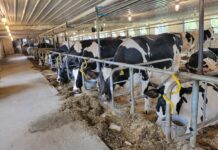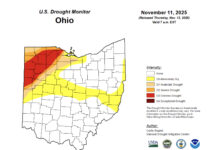COLUMBUS – In March 2001, I wrote an article in Farm and Dairy explaining how local dairy farmers’ milk checks were under attack.
Outside producer milk flooded the Mideast Federal Milk Marketing Order pool, diluting the value of producer milk and farmers’ producer price differential, or PPD.
USDA listened. Producers in the Mideast federal order responded by requesting an emergency hearing from the USDA Agricultural Marketing Service.
The result? Beginning in August 2002, pooling qualifications became more stringent in the Mideast order and much of the outside milk was prevented from qualifying on the pool and diluting the PPD.
Notice I said much of the outside milk.
Outside milk still continues to qualify, with most of it coming from Wisconsin, with lesser amounts from Minnesota, Iowa and Illinois.
This milk meets the August 2002 pool qualification requirements and amounts to an estimated 23 percent of pooled milk in the Mideast order.
New issue. A new, and equally serious, issue emerged – the reverse side of the pool riding issue. I call it ‘pool dodging.’
Just as it was, and still is, advantageous to attach producer milk to a federal order pool with a larger PPD value than your own, it is also advantageous to remove that milk from that pool when it is apparent that the PPD value is going to be negative. This is called depooling.
By depooling milk, milk plants allow their milk producers to retain a much larger share of Class III milk dollars and cause those producers who cannot depool to bear a larger cost.
Depooling has always been a feature of federal milk marketing orders, and pooling is required only of regulated Class I milk plants.
It’s now a problem because this large volume of extra-order milk that finds a convenient home on the Mideast order is swinging in and out of the order.
Why depool? Depooling is the action, on the part of a milk plant, to choose to not participate fully or partially, in the federal order milk pool.
Pooling is compulsory for only Class I milk plants and their producers. For all others, it is a voluntary decision influenced by federal milk market order rules on pooling.
When the management of a manufacturing milk plant determines that the PPD for the month will be negative, they know that the value of their milk in Class III will exceed the uniform or blend price.
If they choose to stay in the federal order pool, they will be in the position where they will be required to pay their producers the uniform price.
That means rather than keeping the excess, they will have to pay the excess of the Class III price over the blend price into the federal order settlement fund.
No-brainer. By choosing depooling, they can keep all of the Class III value and not share it with the other producers in the federal order pool.
In the Mideast order, there are few restrictions on getting producers’ milk back into the pool when the PPD becomes positive, in which case they earn a PPD premium.
The depool-repool decision becomes a no-brainer. Stay in when advantageous and get out when advantageous.
Impact on PPD. Depooling influences the Producer Price Differential two ways.
First, milk is depooled when the Class III price exceeds the Class I price. By depooling milk in Class III use, Class I utilization increases and more weight is given to the lower Class I price in computing the uniform, or blend, price
This increases the deficit between the uniform price and the Class III price.
Second, by depooling producers’ milk, there is a smaller amount of milk remaining in the pool.
The larger deficit is now divided over few pounds of milk and the PPD becomes a larger negative value.
I call this PPD ‘deepening.’
Time for another hearing? Negative PPDs in multiple-component federal orders led to renewed discussion of federal order pooling requirements.
In Federal Order 30, Cass-Clay Creamery, Dairy Farmers of America, Foremost Farms, Land O’Lakes, Mid-West Dairyman’s Company, and four other cooperatives representing producers in Federal Order 30 have filed a petition with the USDA requesting an emergency hearing to tighten pooling requirements.
Here in Federal Order 33, we may want to consider the same action.
Cost to producers. My calculations, not official federal order calculations, for the period July though October 2003, suggest that making the depooling of milk more difficult would have saved those producers whose milk continued to be pooled approximately 22 cents per hundredweight on their total milk shipments during these four months.
About this calculation: First, the PPD aggregate value for June would have been positive and for August through October, negative; second, had more producer milk been required to stay in the pool, the sharing of this on a hundredweight basis would have been lower for each producer.
Gone from milk check. How costly was this for those producers whose milk remained on the Mideast pool?
My estimate of the cost of this “deepening” of the negative PPD was more than $9 million in additional “give-back” for these four months.
In other words, while all producers experienced good milk checks due to high Class III prices, those producers tied to the Mideast pool had to give back an estimated $9 million while those producers whose milk was taken off the pool did not have to share their Class III proceeds.
Most of this depooled milk originates from Wisconsin, Minnesota, Illinois and Iowa.
Equity concerns. There is an equally serious problem of the equity (see related article).
The ability to depool becomes a liability when an estimated 23 percent of normally pooled milk takes a walk and does not contribute to the normal pricing obligations, only to return when advantageous.
This puts Class I milk plants, and their producers, at a serious financial disadvantage compared to other plants and their milk suppliers.
Do we need that milk? How important is this extra-order milk? By my estimate, 328 million pounds of milk moved out and then back into the Mideast federal order July through October 2003 without causing any real disruption in the market.
How can this milk be essential to orderly marketing in the Mideast federal order?
Call to action. Changing the language in the federal order to make it more difficult to depool and then subsequently re-enter the market pool would impact on the equity issue just discussed.
It would not address pricing issues. These would require more extensive modifications to the federal order price rules.
Opening a federal milk marketing order for change should be done with caution.
After an order has been opened for change, producers vote on the package deal and not just the changes. The new order (old language plus new language) must be accepted by a two-thirds vote of the eligible producers to become effective. Otherwise the order is terminated.
(The author is the OSU Extension state specialist for dairy markets and policy.)
* * *
What producers can do:
COLUMBUS – Other federal orders are moving to adopt language that will severely limit the ability to repool, after depooling, on that order. Doing so makes the Mideast federal order the balancing pool for others.
What can we do about this situation? We can’t just sit on our hands.
The Federal Order language spells out clearly what can be done about this and how to go about making necessary modifications to the Mideast Federal Order.
Take action. First, contact the Federal Order 33 Market Administrator office in Cleveland, Ohio.
Send written concerns to David Walker, market administrator, 7851 Freeway Circle, P.O. Box 30128, Cleveland, OH 44130.
Written comments are preferred over phone calls.
You can also contact the USDA Agricultural Marketing Service, Dairy Programs, 1400 Independence Ave. S.W., Washington, D.C. 20250-0225; 202-720-4392.
– Cameron Thraen
Get 4 Weeks of Farm and Dairy Home Delivered












